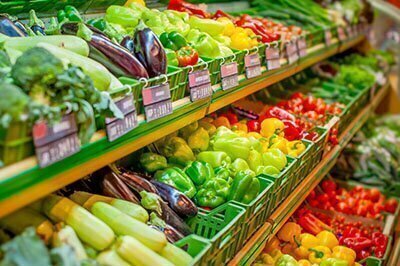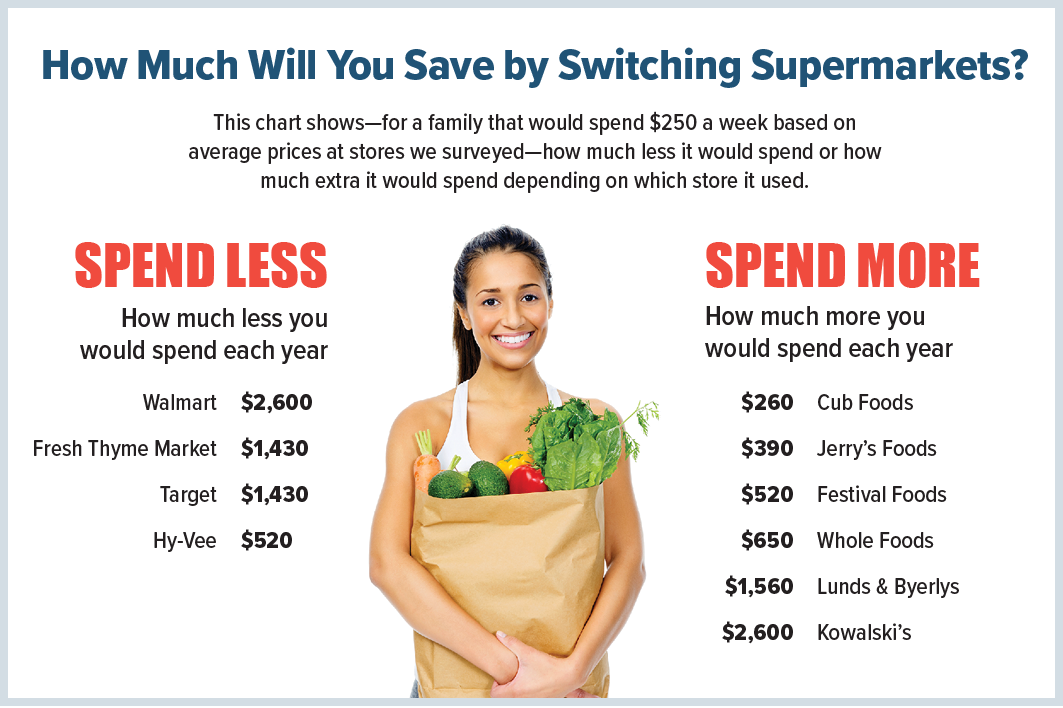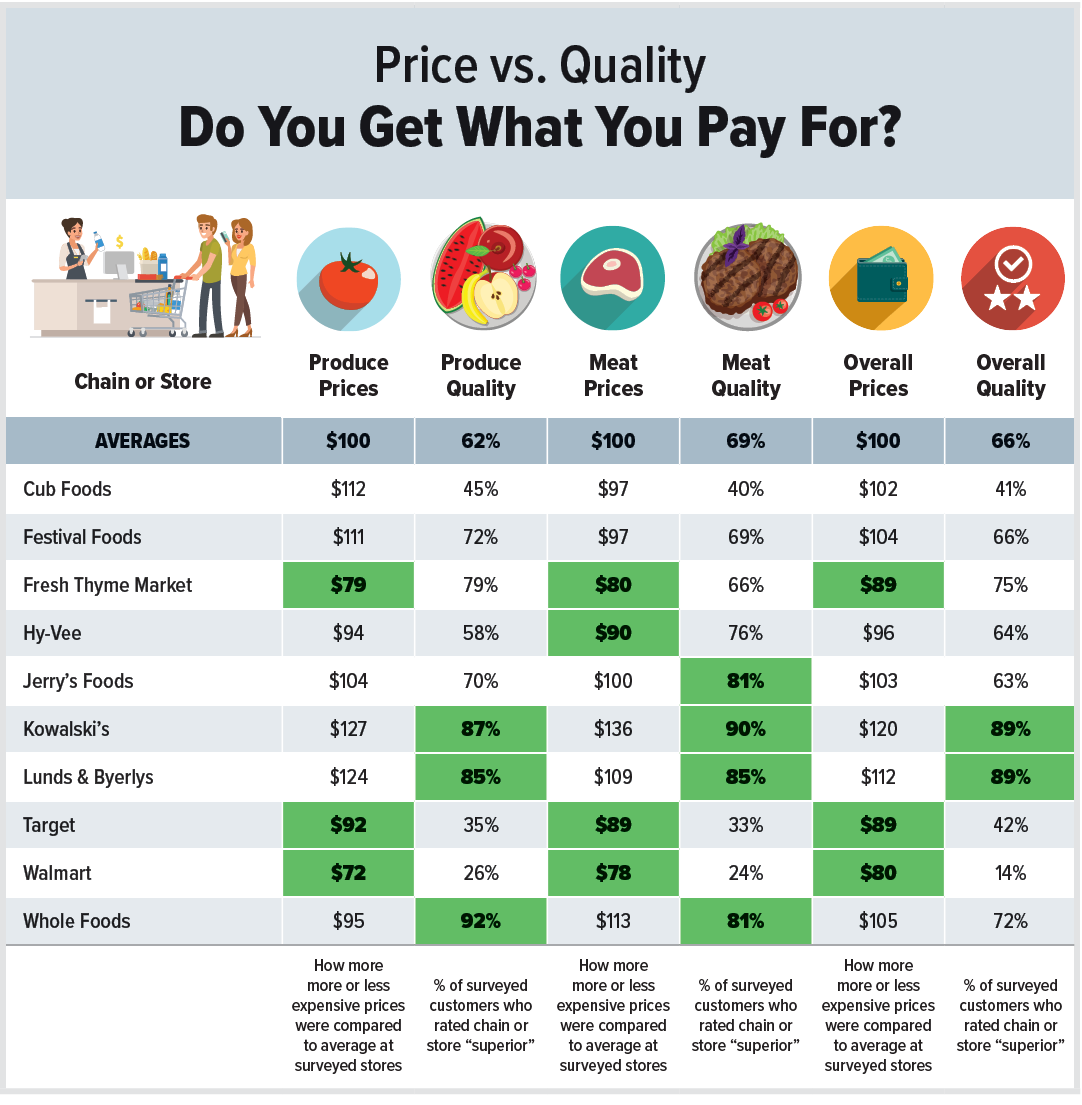Which Grocery Stores Offer the Best Prices and Quality?
Last updated November 2022
Click below to listen to our Consumerpedia podcast episode on how to save at the supermarket.
 Our ratings of Twin Cities area grocery chains and stores report how each stacks up for price and quality. To compare prices, our researchers used a 154-item list of common items to shop area options. To evaluate stores on quality of products and service, we surveyed area consumers. The figures below summarize our findings; for details, see our Ratings Tables.
Our ratings of Twin Cities area grocery chains and stores report how each stacks up for price and quality. To compare prices, our researchers used a 154-item list of common items to shop area options. To evaluate stores on quality of products and service, we surveyed area consumers. The figures below summarize our findings; for details, see our Ratings Tables.
Here’s a rundown of the results:
Hy-Vee and Fresh Thyme continue to impress (mostly).
Fresh Thyme, a chain founded in 2012 that describes itself as “offering fresh and healthy food at amazing values,” now operates seven Twin Cities area stores. Fresh Thyme received favorable scores in our survey of consumers for produce and overall quality, and its overall prices were 11 percent lower than the all-store average.
In our last grocery store report in 2018, Hy-Vee received stellar scores for quality, but the excitement has since ebbed significantly. The chain has expanded its Twin Cities area footprint to 16 area stores and still offers fairly attractive prices (four percent lower than the all-store average, and about six percent lower than Cub’s), but this time around Hy-Vee received “superior” overall ratings from only 64 percent of its surveyed customers.
The area’s price leaders were Fresh Thyme, Target, and Walmart.
Walmart’s prices averaged about 20 percent lower than the average for all surveyed area stores. Fresh Thyme’s and Target’s prices were both about 11 percent lower. For a family that spends $250 per week at the supermarket, an 11-to-20-percent price difference could save them $1,400 to $2,600 a year.
Some Target stores charge higher prices for produce.
We shopped two Target locations. One of them had significantly higher prices for produce than its counterpart. In general, we found that the Target stores around the U.S. that lack scales at checkout, and therefore price produce per piece or package, offer undersized items relative to their price tags. (At Target and other stores that price produce per piece, we used our own scales to weigh items to convert costs to price per pound.)

Whole Foods remains among the area’s more expensive grocery chains.
When Amazon purchased Whole Foods in 2017, many consumers were excited by the prospect of paying Amazon-like prices for Whole Foods-quality products. That hasn’t happened.
Whole Foods built a loyal following by offering high-quality produce, meat, prepared foods, and generic staples, and has always earned high marks in our surveys of consumers, especially for produce and meat quality. But Whole Foods remains one of the more expensive grocery choices in the Twin Cities area. The store we surveyed had prices that were about five percent higher than the all-store average, or 31 percent higher than Walmart, 18 percent higher than Fresh Thyme and Target, and nine percent higher than Hy-Vee.
On the other hand, Whole Foods’ prices for produce were about five percent lower than average, making it a solid choice for high-quality fruits and veggies.
Cub, Target, and Walmart received poor ratings for quality.
Walmart was rated “superior” for “overall quality” by only 14 percent of its surveyed customers, Cub by only 41 percent, and Target by 42 percent.
Kowalski’s Markets and Lunds & Byerlys continue to earn astonishingly high ratings for quality—but offer steep prices.
Both local chains were rated “superior” overall by 89 percent of their surveyed customers, and both received similarly astounding ratings for their produce and meat quality. But Kowalski’s prices were the highest among stores we surveyed—20 percent higher than the all-store average—and Lunds & Byerlys’ prices were about 12 percent higher than average.

Whole Foods’ Amazon Prime discounts don’t add up to much.
Like most other grocery stores, Whole Foods uses “loss leaders”—widely advertised discounts on a small number of items—to draw customers into stores (when calculating our price comparison scores, we include sale prices). But with Whole Foods, there’s a twist: At checkout, Amazon Prime members can automatically get an extra 10 percent off items that are on sale, plus special “Prime Member Deals” for a small number of other weekly special items.
If you shop at Whole Foods often, the 10 percent bonus discount for on-sale items is a nice little benefit—although it’s unlikely many shoppers will rack up enough savings to cover the annual fee for Prime ($139/year or $14.99/month).
Sometimes Amazon/Whole Foods’ Prime Member Deals are designed to garner a lot of attention. For example, for Valentine’s Day the company has hyped that Prime members can buy two dozen roses for $19.99, instead of $24.99. But because Whole Foods and Amazon offer so few of these discounts (usually it’s only two or three items per week), they won’t save most shoppers much money overall.
You can save by substituting store brands and generic products for national brands.
At most stores, when we substituted store brands for about one-sixth of the items in our price-shopping market basket, the total cost of our list dropped by about four percent.
We also compared prices of organic produce and meat, checked out warehouse clubs, looked at unique stores Trader Joe’s and ALDI, and examined grocery delivery options.
Check out the other articles in our “Grocery Stores” category and our ratings tables for info on all the local grocery options, how we rated them, and tips on saving no matter where you shop.


